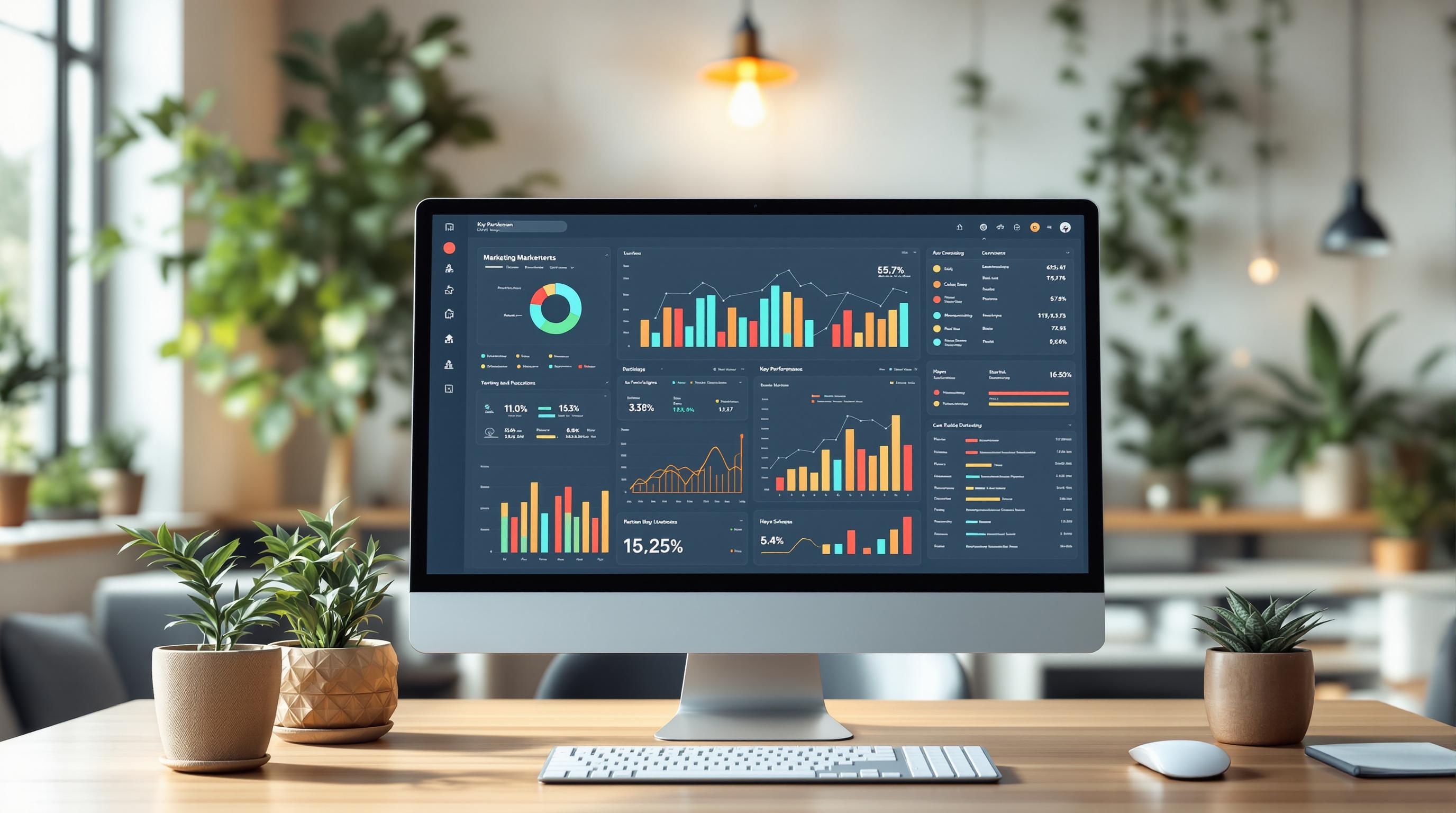Choosing the right campaign tracking tool can make or break your marketing success. Here's how to find the best fit for your needs:
- Define Your Goals: Identify what you want to achieve - brand awareness, conversions, engagement, or ROI.
- List Key Features: Look for essentials like real-time tracking, integration, custom reports, and A/B testing.
- Set a Budget: Balance upfront costs, subscriptions, and ROI potential.
- Compare Tools: Evaluate features, pricing, scalability, and support.
- Test Before Buying: Use free trials or demos to ensure the tool meets your needs.
Quick Comparison Table:
| Tool Name | Key Features | Integrations | Cost | Support | Scalability |
|---|---|---|---|---|---|
| Google Analytics | Web analytics, real-time data | 50+ platforms | Free | Community-based | 5/5 |
| Hootsuite | Social media metrics, ROI | 20+ platforms | $50/month | 24/7 Live Chat | 4/5 |
| ActiveCampaign | Email tracking, CRM integration | 40+ platforms | $100/month | Priority Support | 4.5/5 |
Pro Tip: Start with free tools to understand your needs, then scale up to paid options as your campaigns grow.
Step 1: Identify Your Requirements
Set Your Marketing Goals
Before comparing tools, start by defining your marketing goals. These should be specific and measurable, aligning closely with your overall business strategy.
| Goal Type | Metrics | Tool Requirements |
|---|---|---|
| Brand Awareness | Social mentions, reach | Social listening |
| Conversion Tracking | Sales, sign-ups | Multi-channel attribution |
| Customer Engagement | CTR, time on site | Real-time analytics |
| Campaign ROI | Revenue, CPA | Advanced reporting |
Once you've outlined your goals, pinpoint the features you'll need to achieve them.
List Key Features You Need
Research shows that 85% of marketers rely on data-driven strategies to fine-tune their campaigns [2]. Features like real-time tracking, seamless tool integration, custom reporting, A/B testing, and data visualization are often essential.
When evaluating features, think about:
- How well the tool integrates with your current setup
- Its ability to generate custom reports
- The quality of its data visualization tools
- Real-time tracking capabilities
- Options for testing and experimentation
Set a Budget Range
Budgeting is crucial. Factor in both upfront costs (like setup and training) and recurring expenses (like subscriptions or user licenses). For instance, tools such as Monday.com start at $19 per user per month [3], while more advanced platforms like Voluum, offering multi-channel analytics, come at a higher price point. Always align your spending with the potential return on investment.
Key budget considerations include:
- Setup and onboarding costs
- Monthly or yearly subscription fees
- Additional costs for extra users or features
- Training expenses
- Expected ROI from improved campaign performance
If flexibility is a priority, tools like Monday.com offer pricing that can scale with your needs. On the other hand, platforms like Voluum are tailored for businesses requiring advanced analytics [2]. Once you've determined your budget and feature requirements, you're ready to start comparing tools.
Step 2: Research and Evaluate Tools
Compare Features
When selecting campaign tracking tools, focus on features that align with your marketing goals. Here's a breakdown of key categories to consider:
| Feature Category | Key Considerations | Example Tools |
|---|---|---|
| Analytics Depth | Track conversions, measure ROI, segment audiences | Google Analytics |
| Integration Options | Connect with platforms like Facebook, Instagram, and CRMs | Hootsuite |
| Data Visualization | Build custom dashboards, export data, create interactive charts | Airtable |
| Automation | Schedule campaigns, set trigger-based actions, automate reporting | ActiveCampaign |
Pay attention to how seamlessly a tool integrates with your existing systems. For example, Airtable works with Zapier to simplify workflows across multiple platforms [4].
Once you've shortlisted tools with the right features, the next step is to determine if they fit your budget and can scale with your needs.
Check Pricing and Growth Options
Pricing varies widely across tools. Here's a snapshot of typical costs:
| Tool Type | Representative Tool | Price Range |
|---|---|---|
| Basic Analytics | Campaign Monitor | $9/month |
| Mid-Range Solution | Trackier | $299/month |
| Enterprise Platform | Salesforce | Up to $3,000/month |
Keep in mind additional expenses like storage limits or user licenses. For instance, Monday.com's pricing adjusts based on team size and feature requirements [3].
While cost is important, usability and support are equally critical in ensuring the tool delivers value.
Review Usability and Support
A tool's ease of use and support resources can significantly impact your team's ability to leverage its features. Key aspects to evaluate include:
- Interface design and ease of navigation
- Availability of training materials and support
- User reviews and responsiveness to issues
"The tool's usability and support infrastructure are crucial for ensuring that users can effectively utilize the tool and resolve any issues promptly", according to the Marketing Analytics Tools Directory.
HubSpot, for example, is praised for its intuitive interface and extensive support options [1]. Similarly, Monday.com and Airtable boast high ratings (4.5/5) on Gartner Peer Insights [3].
For a deeper dive into tool comparisons, check out the Marketing Analytics Tools Directory, which offers detailed reviews of various marketing analytics solutions.
Step 3: Organize Your Findings
Create a Comparison Table
Take the information you gathered in Step 2 and arrange it into a comparison table. This lets you evaluate tools side by side based on criteria that matter to you, like features, integrations, and costs.
| Tool Name | Core Analytics Features | Integration Capabilities | Monthly Cost | Support Level | Scalability Rating |
|---|---|---|---|---|---|
| Google Analytics | Web analytics, Demographics, Real-time tracking | High (50+ platforms) | Free | Community-based | 5/5 |
| Hootsuite | Social media metrics, Campaign ROI | Medium (20+ platforms) | $50 | 24/7 Live chat | 4/5 |
| ActiveCampaign | Email performance, CRM data | High (40+ platforms) | $100 | Priority support | 4.5/5 |
Once your table is ready, use it to compare tools based on what’s most important to you.
Prioritize and Rank Tools
Decide how much weight to give each criterion (e.g., features = 40%, pricing = 30%, usability = 30%). Then, score each tool on a 1-5 scale and calculate weighted scores to find the best match for your needs. Remember to think about both your current goals and long-term plans when scoring.
Pro Tip: If you have multiple needs - like tracking social media or managing email campaigns - create separate rankings for each. This will help you find the best tool for every specific task.
With your rankings complete, you’ll be ready to focus on the top tools and start testing them.
sbb-itb-5174ba0
Top Marketing Analytics Tools in 2024
Step 4: Choose the Right Tool
Now that you have your comparison table, it's time to focus on narrowing down your options and testing the most promising tools.
Review and Narrow Down Options
Zero in on the top 2-3 tools that ranked highest in your evaluation. Choose ones that deliver essential features while staying within your budget.
| Factor | What to Evaluate | Example |
|---|---|---|
| Core Features | Key functionality you need | HubSpot for CRM integration |
| Growth Potential | Options for scaling as you grow | Tiered pricing for expansion |
| Integration | How well it works with your tools | Platform connectivity options |
| Support Quality | Levels of assistance offered | Response time and resources |
Once you've identified your top choices, it's time to put them to the test.
Test Tools Before Buying
Use free trials and demos to see how the tools perform in practice. Focus on testing essential features, integrations, ease of use, and the quality of customer support. For instance, Hootsuite offers a 30-day trial starting at $19/month, allowing you to explore their professional features [1].
Pro Tip: During the trial period, set up a test campaign to gauge how the tool performs in real scenarios. If the tool feels clunky or lacks critical features, it's a sign to move on to other options.
For more detailed insights, check the Marketing Analytics Tools Directory. It provides helpful reviews on the reliability and performance of your shortlisted tools.
Resources for Comparing Campaign Tools
The Marketing Analytics Tools Directory is a handy resource to compare campaign tracking tools. It complements your research by providing detailed analyses and real user feedback.
| Feature | How It Helps | Example Use Case |
|---|---|---|
| Categorized Listings | Find tools for specific needs | Filter for real-time analytics tools within budget |
| Detailed Comparisons | Evaluate features side-by-side | Compare Google Analytics vs. Mixpanel capabilities |
| Integration Information | Check tool compatibility | Verify HubSpot integration options |
| Pricing Details | Assess cost implications | Review enterprise vs. startup pricing tiers |
Expert Research Tips:
- Use filters to narrow down tools that align with your specific requirements and integrate seamlessly with your existing systems.
- Pay close attention to pricing details to ensure the tools fit within your budget.
- Look for tools offering free trials or demos to test their functionality firsthand.
The directory also provides expert reviews, case studies, and industry reports that outline the strengths and weaknesses of each tool. For enterprise users, it includes insights into scalability, advanced features, and reporting dashboards - key factors for managing large-scale operations.
Pro Tip: Prioritize tools with free trials or demo options. Hands-on testing helps you fully understand their capabilities before committing, as suggested in earlier testing steps.
These resources will help you confidently finalize your comparison and choose the campaign tracking tool that best meets your needs.
Conclusion: Final Thoughts on Comparing Tools
Key Steps to Follow
Picking the right campaign tracking tool involves a clear, step-by-step process. Start by defining your goals, then compare features across tools, and finally, test the top contenders. This method ensures your choice aligns with both your current requirements and future plans.
With this approach, you're ready to dive into the comparison process using the tools and resources at your disposal.
How to Begin Your Evaluation
A systematic, data-focused evaluation process is essential. Here's a simplified guide:
| Phase | Action | Outcome |
|---|---|---|
| Initial Research | Explore tool types | Create a shortlist |
| Analysis | Compare features and costs | Identify the best options |
| Testing | Try demos or trials | Confirm tool effectiveness |
The Marketing Analytics Tools Directory can help you make informed decisions based on solid data rather than guesswork.
Pro Tip: Start with free tools to better understand your needs before committing to paid options.


